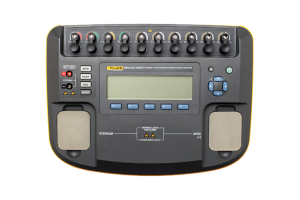Impulse 6000D/7000DP ventricular fibrillation amplitudes
Introduction
Fluke has made some changes to the Impulse 6000D/7000DP ECG amplitudes to improve customer satisfaction with the instrument. This paper describes the implications for the VFib waves.
Reference
lead The reference lead is the lead that matches the ECG Amplitude setting. For example, with a Lead II reference, at a setting of 1 mV Amplitude, Lead II is 1 mV.
All other leads will be a defined percentage of the reference lead.
Firmware change
Firmware changed from version 1.02 to 1.03.
For firmware 1.02 and earlier, Lead I was the ECG reference lead.
For firmware 1.03 and later, you can select either lead I or lead II to be the reference lead, but Lead II is the default selection. The selection is stored in non-volatile memory.
Hardware ECO (Engineering Change Order)
The defib paddle ECG amplitude is always proportional to Lead II.
Originally, the defib paddle ECG amplitude was 40 % of Lead II. The ECO changed 2 resistors in the circuit to make it equal to Lead II.
ECG amplitudes
Normal Sinus wave ECG amplitudes, as a percentage of reference lead setting
| Reference Lead | I | II | III | Defib Paddles with ECO | Defib Paddles before ECO |
|---|---|---|---|---|---|
| II | 70 | 100 | 30 | 100 | 40 |
| I | 100 | 150 | 50 | 100 | 60 |

Ventricular fibrillation (VFIB)
VFib is an important wave needed by Automated External Defibrillators (AEDs). It is an irregular wave that varies throughout but its overall peak to peak amplitude is proportional to a Normal Sinus wave. Fine VFib is 1/2 the amplitude of Coarse VFib:
| Wave | Percentage of Normal Sinus |
|---|---|
| Vfib Coarse | 85 |
| VFib Fine | 42 |
Therefore, the amplitude of VFib Coarse as a percentage of Reference is:
| Reference Lead | i | ii | iii | Defib Paddles with ECO | Defib Paddles before ECO |
|---|---|---|---|---|---|
| II | 60 | 85 | 25 | 85 | 34 |
| I | 85 | 128 | 42 | 128 | 51 |
And the amplitude of VFib Fine as percentage of Reference Lead is:
| Reference Lead | I | II | III | Defib Paddles with ECO | Defib Paddles before ECO |
|---|---|---|---|---|---|
| II | 30 | 42 | 12 | 42 | 17 |
| I | 42 | 64 | 21 | 64 | 26 |
To get an AED to recognize VFib, the user should be aware of these amplitudes.
If the amplitude is too small, the AED might not get enough signal to recognize it.
If the amplitude is too large, the AED might think the VFib transitions are beats instead of fibrillation.
The user can adjust the ECG Amplitude setting as needed to get the AED to recognize the VFib.
